What Is Life Science Sales Enablement? Strategies for Smarter Selling
The life sciences industry operates in a uniquely challenging environment, characterized by complex buying processes, stringent regulatory frameworks, and diverse stakeholder groups. Sales and marketing teams are constantly striving to engage effectively with healthcare professionals (HCPs), procurement teams, and administrators while adhering to compliance requirements.
Consider a sales representative introducing a new diagnostic tool to a healthcare provider. This seemingly straightforward task involves navigating multiple decision-makers—clinicians, procurement officers, and administrative leaders—while ensuring that all shared content complies with medical regulations.
A 2023 survey highlighted that 70% of life sciences sales professionals cite multi-stakeholder engagement as their greatest hurdle.
Summary
So let's take a look at what we will be exploring today - Life sciences teams face unique challenges, including multi-stakeholder buying processes, stringent compliance regulations, and the difficulty of delivering personalized content. Sales enablement plays a crucial role in addressing these challenges by streamlining workflows, ensuring regulatory compliance, and improving engagement with key stakeholders.
By leveraging the right strategies and tools, life sciences organizations can enhance their sales processes, drive better customer experiences, and achieve greater efficiency.
This blog delves into the importance of sales enablement, its impact on the industry, and specialized tools designed to meet the needs of life sciences professionals.
- Sales Enablement for Life Sciences
- Why Sales Enablement is Crucial for Life Sciences
- How Sales Enablement Transforms Life Sciences Sales and Operations
- Implementing Sales Enablement in Life Sciences
- Top Sales Enablement Tools for Life Sciences
Sales Enablement for Life Sciences
Sales enablement in the life sciences industry equips teams with the tools and strategies needed to overcome unique challenges, such as navigating multi-stakeholder engagements, ensuring strict regulatory compliance, and optimizing sales processes.
By leveraging data-driven insights, centralized resources, and personalized content, organizations they can enhance efficiency, reduce delays, and drive stronger stakeholder engagement.
For example, sales enablement empowers life sciences teams to manage intricate buying processes with tailored strategies, ensuring that all sales and marketing communications adhere to industry regulations. Additionally, streamlined workflows and intelligent automation help sales teams stay agile, improve collaboration, and deliver relevant content to the right stakeholders at the right time.
Why Sales Enablement is Crucial for Life Sciences
Life sciences teams operate in a highly regulated and complex environment, facing challenges that set them apart from other industries. Sales enablement plays a pivotal role in addressing these challenges by equipping teams with the right tools, data, and strategies to streamline operations and enhance engagement.
It ensures that all sales and marketing communications remain compliant, enables personalized and relevant interactions, and centralizes resources for better efficiency. By leveraging sales enablement, life sciences organizations can drive stronger relationships, accelerate sales cycles, and ultimately improve business outcomes in a competitive landscape.
Now let us look at some of the major challenges of the life sciences industry and how we can address them using sales enablement!
1. Multi-Stakeholder Buying Processes
Challenge: Engaging a diverse array of stakeholders—from clinicians and researchers, to administrators—each with their own priorities and concerns.
Solution: Sales enablement platforms like Paperflite offer segmentation capabilities that allow sales reps to deliver tailored content to each stakeholder group. This ensures that messaging resonates with the unique needs of each decision-maker, facilitating more effective engagement.
2. Regulatory Compliance
Challenge: The life sciences sector is governed by strict regulations from bodies like the FDA and EMA. Ensuring that all marketing and sales materials are compliant across different markets is a constant challenge.
Solution: Centralized content management systems ensure that all materials are pre-approved and adhere to both local and international regulations. Certain sales enablement platforms automate content approvals, reducing the risk of non-compliance.
3. Content Personalization
Challenge: Life sciences audiences are highly specialized, requiring tailored materials to effectively address their specific concerns and interests.
Solution: AI-driven personalization tools help sales reps deliver relevant content aligned with each audience’s unique needs.
Sales enablement is revolutionizing how life sciences teams operate by optimizing key processes, improving stakeholder engagement, and driving measurable business outcomes. By equipping sales professionals with the right tools, content, and insights, sales enablement enhances efficiency and effectiveness across the entire sales cycle.
How Sales Enablement Transforms Life Sciences Sales and Operations
By integrating sales enablement strategies, life sciences companies can optimize sales performance, enhance stakeholder relationships, and drive long-term business success in an increasingly competitive and regulated industry
Listed below are some of the most important ways in which sales enablement has an impact on pharma industry.
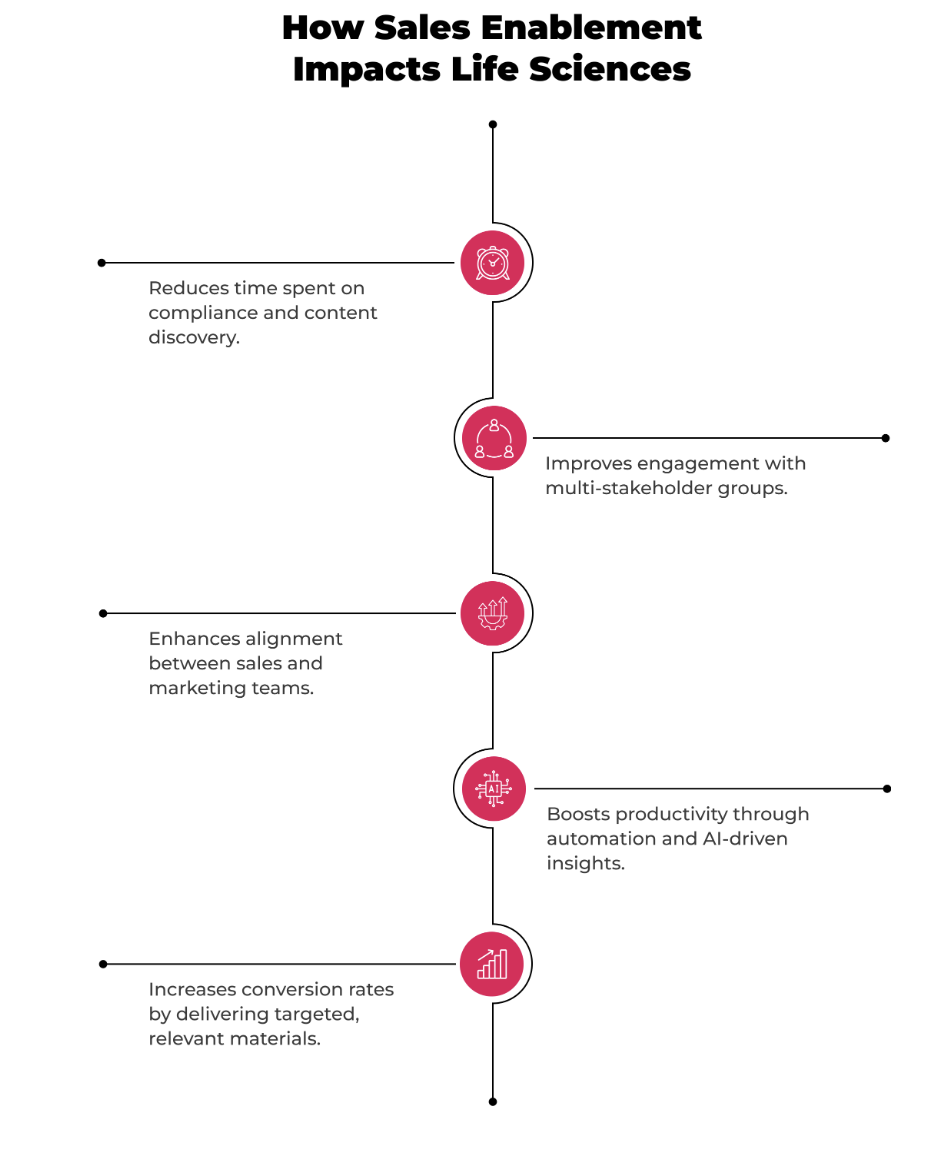
1. Reduced Time Spent on Compliance and Content Discovery
Navigating stringent compliance requirements can be time-consuming, but sales enablement streamlines this process. Centralized content repositories ensure that sales teams have instant access to approved, up-to-date materials, reducing time spent searching for compliance-approved resources.
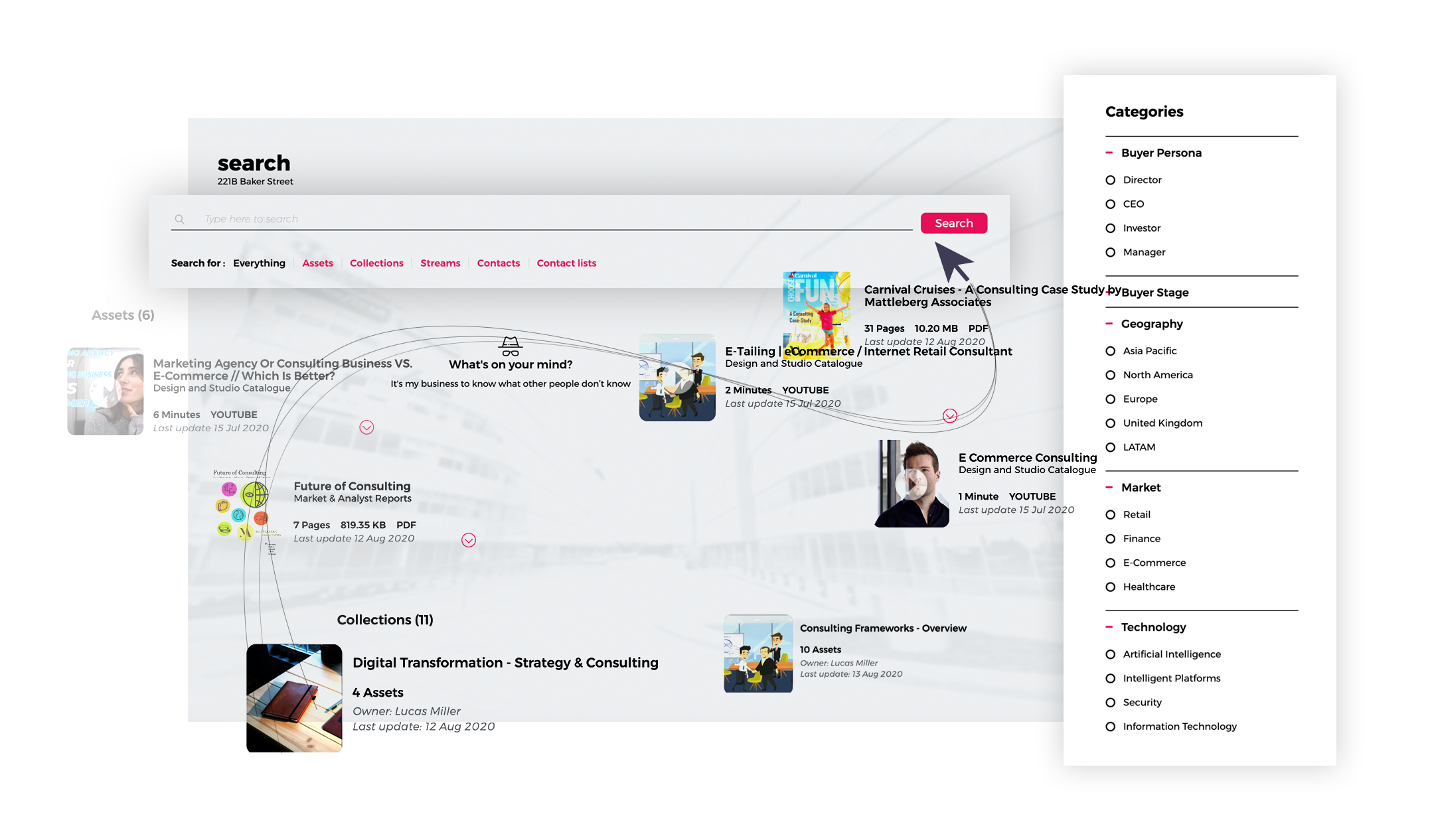
Automated compliance checks further minimize regulatory risks, allowing sales representatives to focus more on strategic engagement with stakeholders.
2. Improved Engagement with Multi-Stakeholder Groups
The life sciences industry involves complex sales processes that require collaboration with diverse stakeholder groups, including healthcare providers, regulatory authorities, procurement teams, and executives. Sales enablement enhances engagement by delivering tailored content and personalized communication strategies that address the unique concerns of each group.
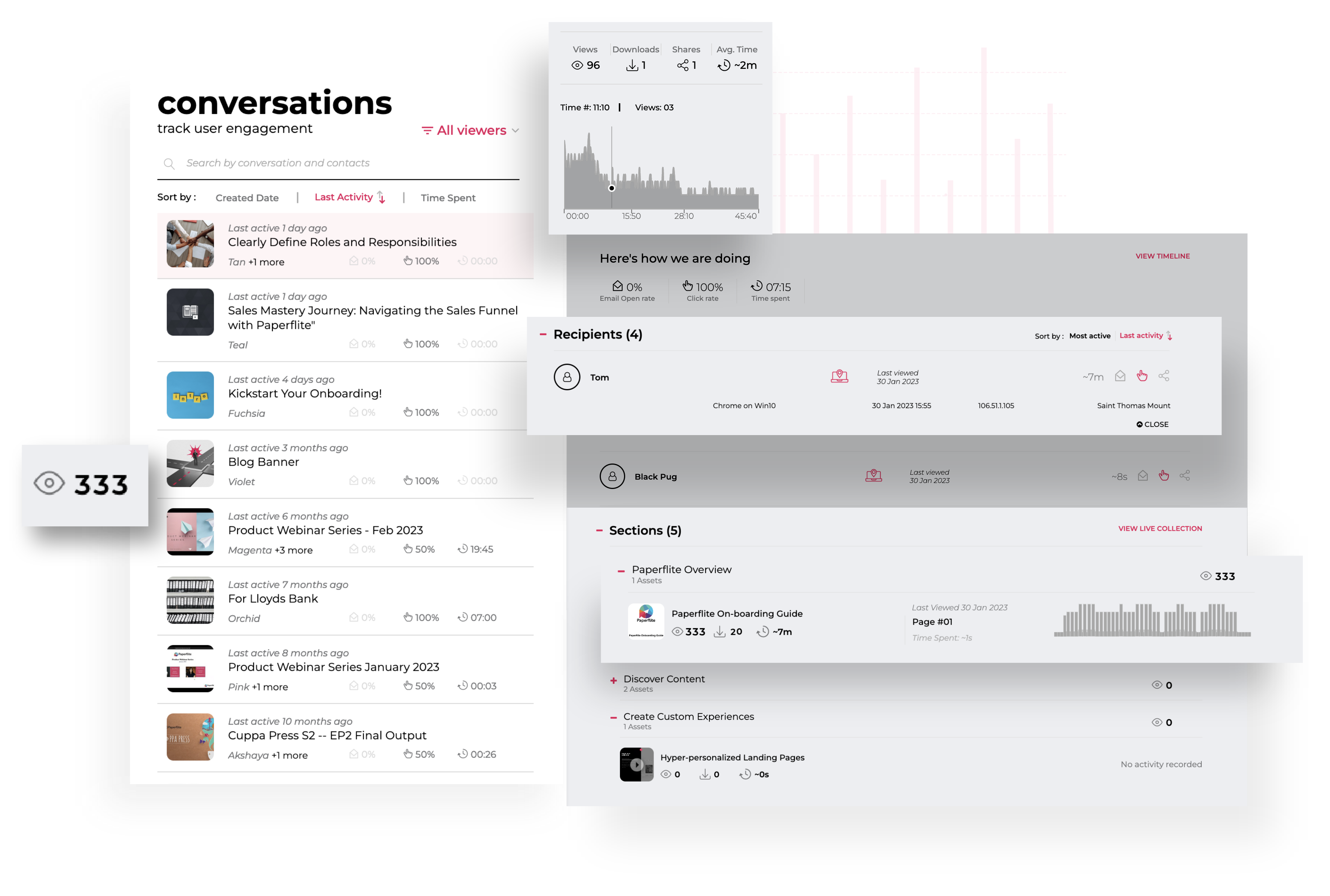
This leads to more meaningful interactions, fostering trust and stronger relationships.
3. Enhanced Alignment Between Sales and Marketing Teams
A well-integrated sales enablement strategy with a platform bridges the gap between sales and marketing teams, it ensures that they work cohesively toward shared objectives. With access to real-time data and analytics, sales teams can leverage marketing-driven insights to deliver consistent messaging.
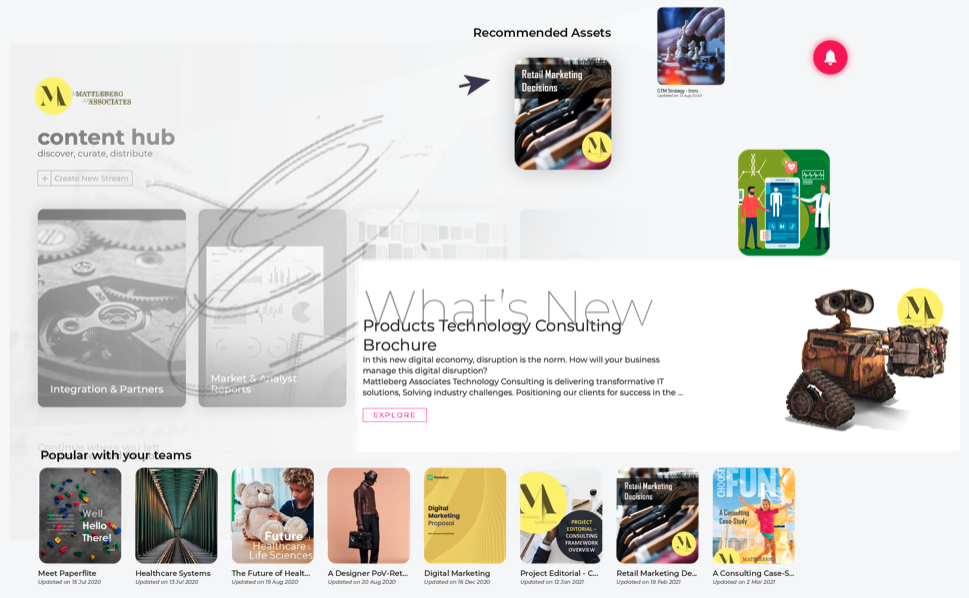
This alignment leads to more effective campaigns, higher-quality leads, and a smoother transition from marketing-qualified to sales-qualified prospects.
4. Boosted Productivity Through Automation and AI-Driven Insights
Automation and artificial intelligence (AI) play a critical role in increasing sales efficiency. By automating repetitive administrative tasks, such as data entry, follow-ups, and report generation, sales teams can allocate more time to high-value activities.

AI-powered insights provide actionable intelligence on stakeholder behavior, preferences, and engagement patterns, allowing sales professionals to make data-driven decisions and refine their strategies.
5. Increased Conversion Rates Through Targeted, Relevant Materials
Delivering the right information at the right time is essential for accelerating the sales cycle. Sales enablement platforms empower sales representatives with data-driven content recommendations, ensuring they present the most relevant materials to prospects. This targeted approach not only improves conversion rates but also shortens the sales cycle, leading to faster revenue generation and improved customer satisfaction.
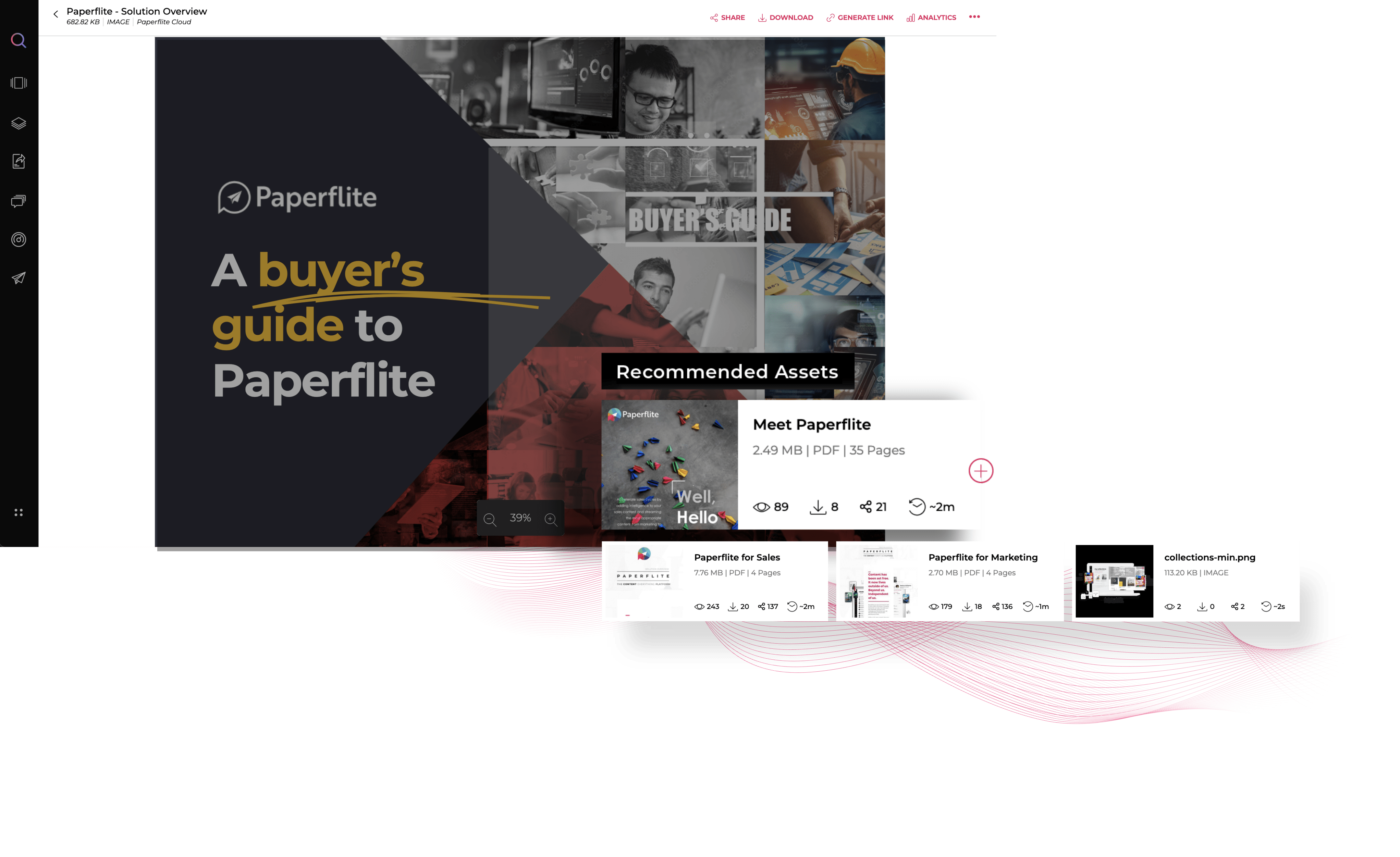
Implementing Sales Enablement in Life Sciences
Successfully implementing sales enablement in the life sciences industry requires a strategic and holistic approach that supports the entire sales cycle, from onboarding new team members to closing deals and maintaining long-term customer relationships.
Given the complexity of the industry, sales enablement must align with regulatory requirements, scientific communication needs, and multi-stakeholder engagement strategies.
1. Onboarding
Equip new sales reps with comprehensive compliance training and provide access to a centralized hub of pre-approved content. This ensures that new hires are well-prepared to engage with stakeholders in a compliant and effective manner.
2. Prospecting
Utilize sales enablement tools to identify key stakeholders within healthcare institutions and research facilities. AI-powered segmentation capabilities can help pinpoint the most relevant contacts for each product or service.
3. Engagement
Provide secure, personalized microsites where stakeholders can access relevant materials. Tools like Paperflite allow for the creation of digital sales rooms tailored to each stakeholder group, enhancing engagement and fostering trust.
4. Closing Deals
Leverage analytics to measure stakeholder engagement and tailor follow-up communications accordingly. sales enablement tools also offer detailed insights into how stakeholders interact with content, enabling sales reps to refine their strategies and close deals more effectively.
Top Sales Enablement Tools for Life Sciences
Choosing the right sales enablement tools is crucial for maximizing effectiveness and ensuring compliance in the life sciences industry. Here are some of the top platforms tailored for this sector:
1. Paperflite

Paperflite is a powerful sales enablement solution designed to help life sciences organizations manage content, ensure compliance, and personalize stakeholder interactions. With robust AI-driven capabilities, Paperflite optimizes sales processes by making content discovery, regulatory adherence, and engagement tracking more efficient.
Key Features:
- HIPAA-Compliant, Centralized Content Repository: Ensures that all marketing and sales materials adhere to healthcare industry regulations while providing a single, easily accessible platform for content management.
- AI-Powered Segmentation for Multi-Stakeholder Management: Categorizes and customizes content for different stakeholder groups, such as clinicians, procurement teams, and regulatory bodies, ensuring that each receives relevant and compliant materials.
- Personalized Microsites and Digital Sales Rooms: Enables sales teams to create customized, interactive digital spaces where stakeholders can access curated content, product demos, and compliance-approved documentation.
- CRM Integrations with Salesforce and HubSpot: Seamlessly integrates with leading customer relationship management (CRM) platforms, allowing sales teams to track engagement, streamline workflows, and maintain data consistency across systems.
AI Capabilities:
- Automated Compliance Checks: Uses AI to review content for regulatory adherence, reducing the risk of non-compliance and ensuring materials meet industry standards.
- Streamlined Content Customization: AI-driven insights help sales teams tailor content for specific stakeholders, improving engagement and relevancy.
- Engagement Analytics: Tracks how stakeholders interact with shared content, providing data-driven insights to refine sales strategies and optimize outreach.
2. Showpad

Showpad is a dynamic sales enablement platform designed to support life sciences organizations in delivering engaging, interactive content to a diverse global audience. By combining content management, training, and AI-driven personalization, Showpad helps sales teams optimize stakeholder interactions and improve overall efficiency.
Key Features:
- Interactive Content Delivery for Global Audiences: Enables sales teams to present multimedia-rich content in engaging formats, ensuring a compelling experience for stakeholders across different regions and languages.
- Centralized Content Library: Provides a structured, easily accessible repository for sales and marketing teams to store, manage, and share approved materials.
- Sales Training and Coaching: Offers built-in training modules to upskill sales representatives, ensuring they remain informed about new products, regulatory changes, and market trends.
- Performance Analytics and Engagement Insights: Tracks content usage, audience engagement, and sales performance to help teams refine their strategies and maximize impact.
- Collaboration Tools: Allows sales and marketing teams to work seamlessly, ensuring alignment in messaging and strategy across multiple regions.
AI Capabilities:
- Personalization Tools for Multi-Market Engagement: Uses AI to tailor content and messaging based on the specific needs of different markets, ensuring relevance and compliance with local regulations.
- Content Recommendations: AI-driven insights suggest the most effective materials for each stage of the sales cycle, improving engagement and conversion rates.
- Intelligent Search Functionality: Helps sales representatives quickly find the most relevant content, reducing time spent searching for materials and improving efficiency.
3. Highspot
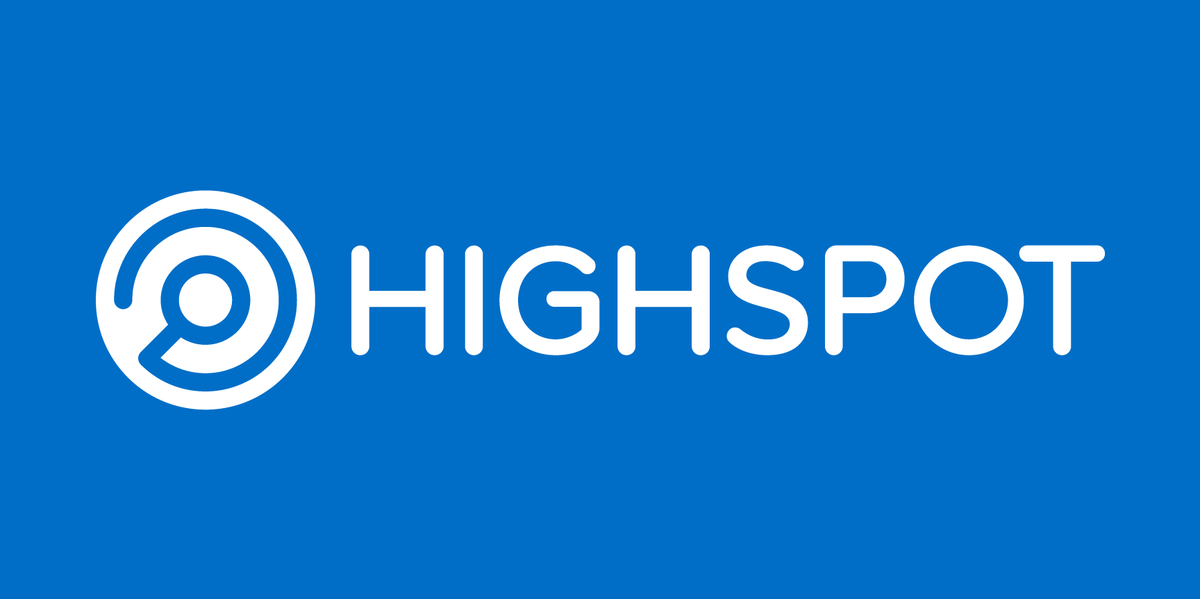
Highspot is a robust sales enablement platform that equips life sciences sales teams with advanced analytics, AI-powered insights, and intuitive content management tools. Designed to optimize sales performance, Highspot enables teams to track content effectiveness, gain a deeper understanding of stakeholder behavior, and improve engagement through data-driven decision-making.
Key Features:
- Detailed Analytics for Content Performance and Stakeholder Engagement: Provides in-depth metrics on how sales content is being used, which materials are most effective, and how stakeholders interact with shared resources.
- Content Organization and Searchability: Centralized content repository with intuitive search functionality, ensuring sales teams can quickly access the most relevant and up-to-date materials.
- Sales Playbooks and Guidance: Offers structured sales guidance within the platform, helping reps navigate complex multi-stakeholder interactions with recommended strategies and content.
- Integration with CRM and Productivity Tools: Seamlessly connects with platforms like Salesforce, Microsoft Teams, and other sales and collaboration tools, ensuring workflow efficiency.
AI Capabilities:
- Stakeholder Behavior Insights: Uses AI-driven analytics to track stakeholder interactions with content, providing sales teams with actionable insights to refine their approach.
- Automated Content Recommendations: Suggests the most relevant materials for different buyer personas and sales stages, helping teams deliver highly targeted and personalized communications.
- Engagement Forecasting: Predicts which stakeholders are most likely to engage based on past interactions, allowing sales teams to prioritize high-value opportunities.
Pros & Cons:
- Pro: Powerful analytics and AI-driven insights that enhance sales strategies and optimize stakeholder engagement.
- Con: Less focus on compliance-specific features, which may require additional oversight and manual validation to ensure regulatory adherence in life sciences.
4. Seismic
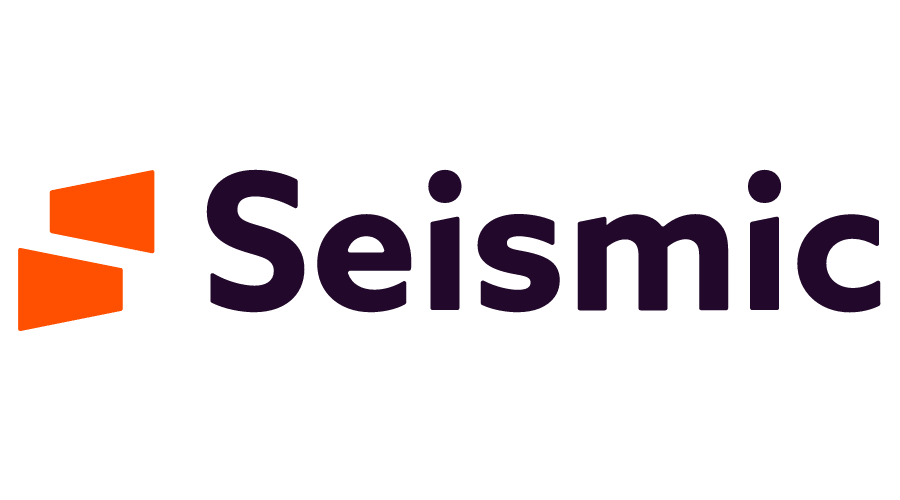
Seismic is a top-tier sales enablement platform that empowers life sciences sales teams with AI-driven content management, automation, and compliance tools. Designed to help organizations streamline content distribution, improve stakeholder engagement, and maintain regulatory compliance, Seismic is widely adopted by large enterprises seeking a comprehensive, data-driven approach to sales enablement.
Key Features:
- Automated Content Approvals and Distribution: Ensures that only compliance-approved content is accessible to sales teams, reducing regulatory risks and maintaining consistency across communications.
- Dynamic Content Personalization: Allows sales representatives to customize materials for different stakeholders while ensuring adherence to brand and regulatory guidelines.
- AI-Powered Content Recommendations: Uses machine learning to suggest the most relevant materials based on stakeholder interactions, sales cycle stage, and past engagement history.
- Advanced Sales Analytics and Performance Insights: Provides detailed reports on content engagement, stakeholder behavior, and overall sales effectiveness, helping teams refine their strategies.
- Seamless CRM and Business Tool Integration: Connects with Salesforce, Microsoft Dynamics, and other enterprise systems to enhance workflow efficiency and data synchronization.
- Interactive Training and Onboarding Modules: Includes built-in training programs to keep sales teams informed about new regulations, market trends, and product updates.
AI Capabilities:
- Predictive Analytics to Optimize Sales Strategies: Uses AI to identify trends in stakeholder engagement and recommend data-driven actions that improve conversion rates.
- Automated Compliance Monitoring: Ensures that sales teams always use up-to-date, regulatory-compliant content by flagging outdated or unauthorized materials.
- Content Performance Forecasting: Predicts which sales materials will be most effective based on historical engagement data, helping teams prioritize high-impact resources.
Pros & Cons:
- Pro: Strong automation and compliance capabilities make it ideal for highly regulated industries like life sciences.
- Con: Higher price point may be prohibitive for smaller teams or organizations, making it more suitable for mid-sized to large enterprises.
Conclusion
To recapitulate, Sales enablement is a game-changer for the life sciences industry, addressing critical challenges such as multi-stakeholder engagement, regulatory compliance, and content personalization. By leveraging advanced tools like Paperflite, life sciences organizations can streamline their sales processes, ensure regulatory alignment, and enhance stakeholder engagement.
Explore the advanced features of sales enablement platforms like Paperflite to revolutionize your sales and marketing efforts in the life sciences industry. By implementing these tools and strategies, your team can navigate the complexities of the industry with greater efficiency and effectiveness, ultimately driving better outcomes and improved KPIs.
